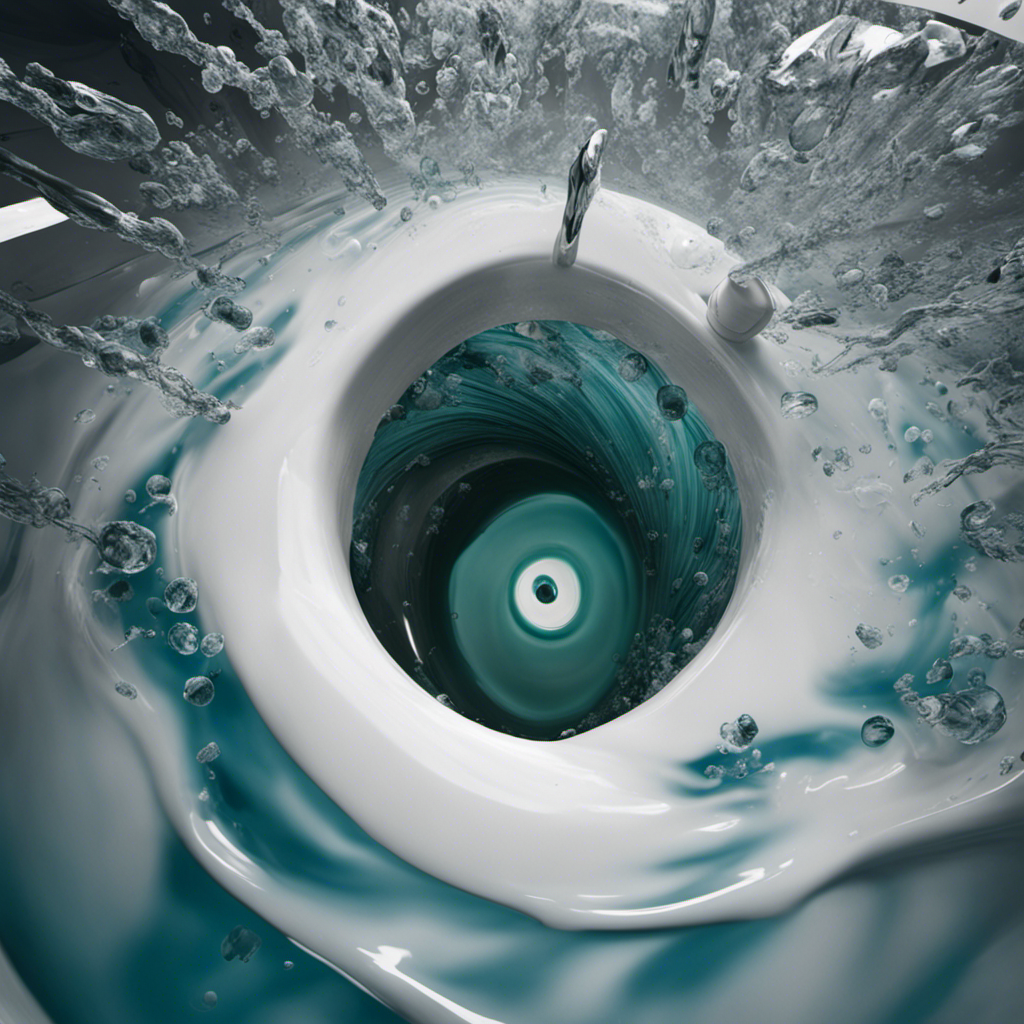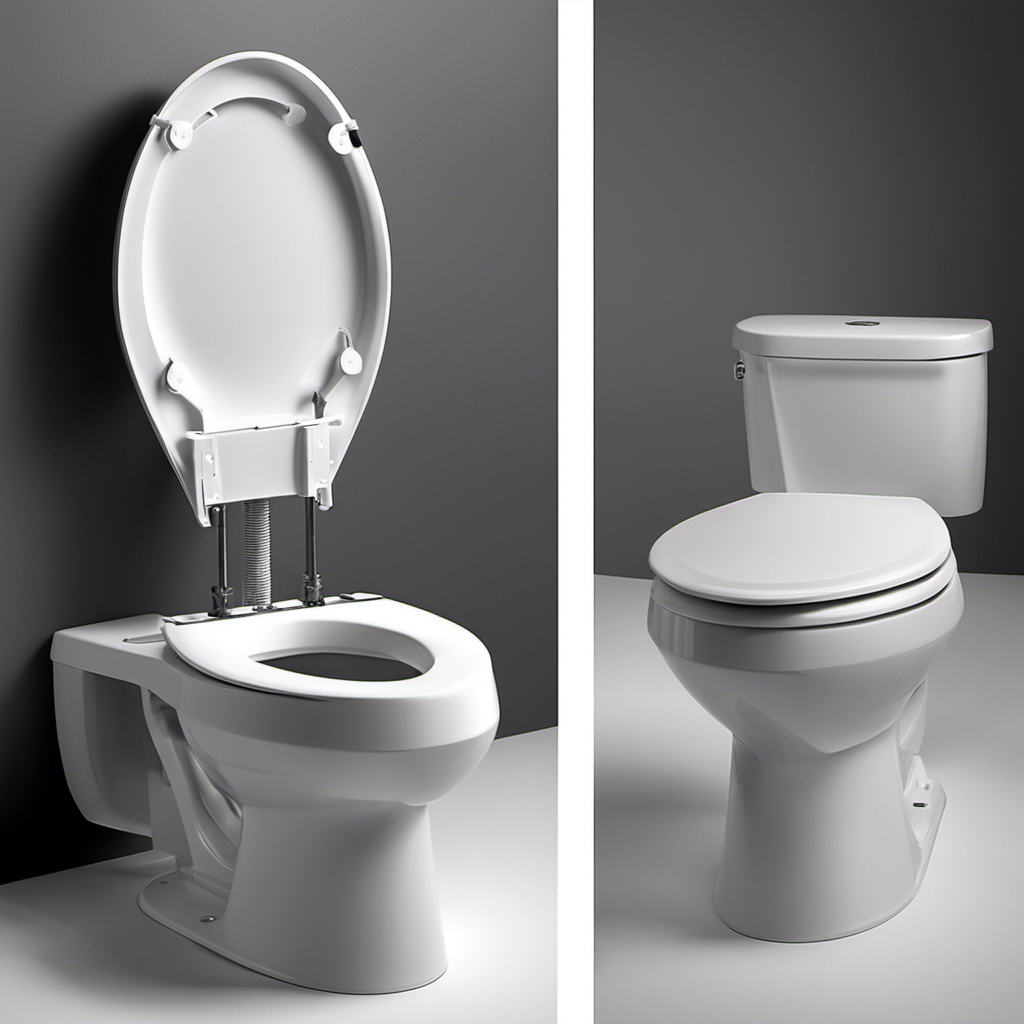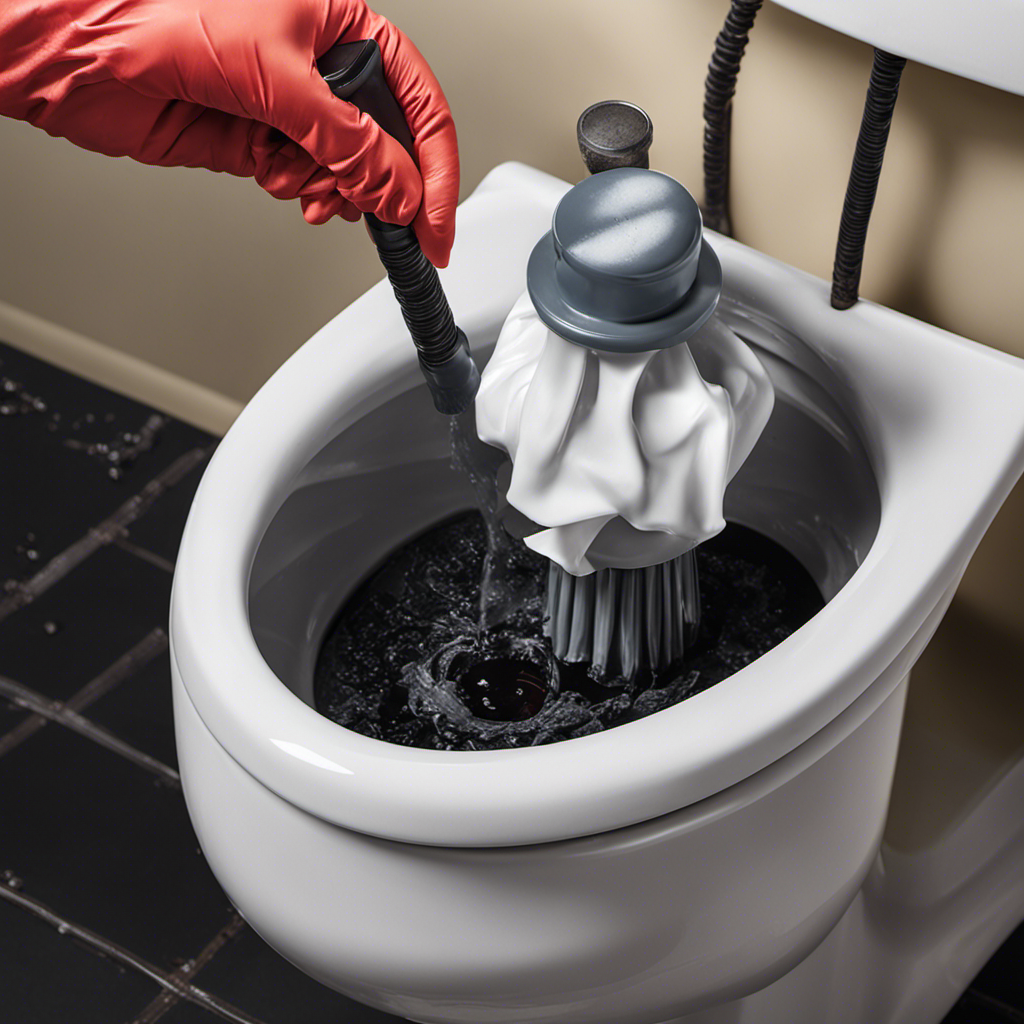Hey there! Ever wondered why your toilet drains slowly when flushed? Well, I’ve got some answers for you.
In this article, we’ll dive into the common causes of this frustrating issue and help you determine if your toilet is indeed draining slowly.
But don’t worry, it’s not all doom and gloom! We’ll also provide you with some practical DIY solutions to try, as well as the option of calling in professional plumbing services.
So let’s get started and put an end to that slow-draining toilet once and for all!
Key Takeaways
- Common causes of slow-draining toilets include clogged pipes, foreign objects, debris buildup, blocked sewer lines, and faulty flapper valves.
- To determine if your toilet is draining slowly, observe the time it takes for water to go down, check for visible signs of damage, inspect the flapper valve, and ensure there are no clogs or blockages.
- DIY solutions for a slow-draining toilet include conducting a plumbing inspection, using a plunger or drain snake, and using a mixture of hot water, baking soda, and vinegar to dissolve the clog.
- If DIY solutions don’t work, it’s recommended to seek professional plumbing services as they have the expertise and tools to diagnose and fix the issue efficiently.
Common Causes of Slow-Draining Toilets
One common cause of slow-draining toilets is a clogged pipe. When the pipe that carries waste from the toilet to the sewer becomes blocked, water cannot flow freely, resulting in a slow drain.
This clog can be caused by various things, such as excessive toilet paper, foreign objects flushed down the toilet, or a buildup of debris and sediment over time.
To fix a slow-draining toilet, there are a few steps you can take. First, try using a plunger to dislodge the clog. If that doesn’t work, you can try using a toilet auger or a drain snake to break up the blockage.
How to Determine if Your Toilet Is Draining Slowly
You can easily tell if your toilet is not emptying quickly by observing how long it takes for the water to go down after you press the lever. If it takes longer than usual, there might be a problem with your toilet’s drainage system.
Here are some troubleshooting tips to help you determine if your toilet is draining slowly.
First, check for any visible signs of damage, such as cracks or leaks in the toilet bowl or tank.
Next, inspect the flapper valve to see if it is closing properly after each flush.
Additionally, make sure there are no clogs or blockages in the toilet’s trap or drainpipe.
If you notice any of these signs of damage or issues, it’s important to address them promptly to prevent further problems with your toilet’s drainage.
DIY Solutions for a Slow-Draining Toilet
So, you’ve determined that your toilet is draining slowly when flushed. This can be caused by clogged pipes, which can greatly affect the efficiency of your toilet.
Luckily, there are some simple DIY methods you can try to fix a weak flush and unclog your toilet.
Clogged Pipes Causing Slowness
If your toilet drains slowly when flushed, it’s likely due to clogged pipes. Clogged drains can be a common plumbing issue that many homeowners face.
To diagnose the problem and find a solution, consider the following steps:
-
Conduct a plumbing inspection:
-
Check for any visible signs of blockage, such as overflowing or gurgling drains.
-
Use a flashlight to inspect the drain pipe for any obstructions or buildup.
-
Look for signs of leaks or corrosion in the pipes.
-
Attempt DIY solutions:
-
Use a plunger to try and dislodge the clog.
-
Use a drain snake or auger to reach deeper into the pipes and remove any blockages.
-
Try using a mixture of hot water, baking soda, and vinegar to break down the clog.
-
Seek professional help:
-
If the DIY solutions don’t work, it’s best to call a professional plumber.
-
They will have the necessary tools and expertise to safely and effectively clear the clog.
Fixing a Weak Flush
To fix a weak flush, check the water level in the tank and adjust the float if necessary. The water level should be about an inch below the overflow tube. If it’s too low, the toilet may not have enough water to create a strong flush.
Another possible cause of a weak flush is a malfunctioning toilet flapper. This is the rubber seal that opens and closes to allow water to flow into the bowl. If it’s worn out or not sealing properly, it can reduce the water pressure and result in a weak flush. Check the flapper for any signs of damage or debris and replace it if needed.
Lastly, make sure the water pressure in your home is adequate. Low water pressure can also contribute to weak flushing. If you suspect low water pressure, you may need to contact a plumber to assess and fix the issue.
DIY Unclogging Methods
Now that we’ve tackled the issue of a weak flush, let’s move on to DIY unclogging methods for when your toilet drains slowly when flushed.
One effective method is using a toilet plunger. Here’s how you can do it:
- First, ensure there is enough water in the toilet bowl to cover the rubber part of the plunger.
- Place the plunger over the drain hole and firmly push down, then pull up rapidly. Repeat this motion several times.
If the plunger method doesn’t work, another option is to use the vinegar and baking soda method. Here’s what you need to do:
- Pour one cup of baking soda into the toilet bowl.
- Follow it with two cups of vinegar.
- Let the mixture sit for about 30 minutes.
- Finally, flush the toilet to see if the clog has cleared.
These DIY methods can often unclog a slow-draining toilet without the need for professional assistance.
Professional Plumbing Services for Slow-Draining Toilets
When your toilet drains slowly, it’s time to consider professional plumbing services. Regular toilet maintenance is essential to prevent clogs and ensure proper functioning.
Hiring professional plumbers for toilet repairs offers several benefits. Firstly, they have the expertise and tools to accurately diagnose the issue and provide effective solutions. They can identify underlying problems that may be causing the slow drainage, such as a clogged sewer line or a malfunctioning toilet mechanism.
Secondly, professional plumbers can efficiently unclog the toilet using specialized equipment, minimizing the risk of further damage. Additionally, they can provide advice on how to prevent future clogs and offer maintenance tips to keep your toilet running smoothly.
Preventive Maintenance to Avoid Slow-Draining Toilets
Regular maintenance is crucial for preventing slow drainage in your toilet. By following a preventive maintenance schedule and regularly cleaning your toilet, you can ensure that it functions properly and avoids any issues with slow-draining.
Here are some important steps to include in your preventive maintenance routine:
- Regularly clean the inside of the toilet bowl and around the rim to remove any buildup of mineral deposits or other debris.
- Check the flapper valve and flush valve for any signs of wear or damage, and replace them if necessary.
- Inspect the toilet tank and water supply line for leaks or blockages, and address any issues promptly.
Signs of a More Serious Issue With a Slow-Draining Toilet
If you’ve noticed that your toilet is draining slowly, it could be a sign of a more serious issue.
There are three key points to consider: a clogged sewer line, a damaged toilet flange, or a problem with the septic tank.
Each of these issues can cause your toilet to drain slowly and may require professional assistance to fix.
It’s important to address these problems promptly to avoid further damage and ensure the proper functioning of your toilet.
Clogged Sewer Line
To clear a clogged sewer line, you might need to call a professional plumber. A clogged sewer line can cause a host of problems, including a septic system backup. Here are some things to consider when dealing with a clogged sewer line:
-
Check for multiple drain clogs: If multiple drains in your home are slow or backing up, it could be a sign of a clogged sewer line.
-
Watch for unusual gurgling sounds: If you hear gurgling sounds coming from your drains or toilet when you flush, it may indicate a clog in the sewer line.
-
Pay attention to foul odors: A sewer line clog can cause unpleasant odors to emanate from your drains or toilets.
Damaged Toilet Flange
When your toilet flange is damaged, you’ll need a professional plumber to repair it. A toilet flange is an important component that connects your toilet to the sewer pipe and ensures a proper seal. If it becomes damaged, it can cause leaks and other problems.
Here are some common signs of a damaged toilet flange:
- Toilet wobbling or rocking
- Water pooling around the base of the toilet
- Foul odors coming from the bathroom
- Toilet not flushing properly or backing up
If you notice any of these signs, it’s crucial to address the issue promptly to prevent further damage. A professional plumber can assess the situation and determine if a toilet flange replacement is necessary. Ignoring a damaged toilet flange can lead to more extensive repairs and even water damage. So, don’t hesitate to call a plumber if you suspect a problem with your toilet flange.
Now, let’s move on to the next section about ‘septic tank problems?’…
Septic Tank Problem?
After discovering a damaged toilet flange, I wanted to rule out any other potential causes for my slow-flushing toilet. One possibility that crossed my mind was a septic tank problem. Septic tank maintenance is crucial to prevent costly repairs or replacements. Here are some signs of septic tank failure that I learned about:
- Foul odors emanating from the drains or yard
- Slow draining sinks and showers
- Gurgling sounds in the plumbing system
To avoid a septic tank disaster, it’s essential to take proactive steps in maintaining it:
- Regularly inspect and pump the septic tank
- Avoid flushing non-biodegradable items down the toilet
- Use septic-safe products to prevent damage to the tank
Troubleshooting Tips for a Slow-Draining Toilet
One of the first things you can try is using a plunger to unclog the toilet. If the water drains slowly when you flush, it could be due to a blockage in the toilet drainage system. Start by positioning the plunger over the drain hole and creating a tight seal. Then, push and pull the plunger vigorously to create suction and dislodge the obstruction.
If the plunger doesn’t work, you can try using a toilet auger. Insert the auger into the drain and rotate the handle to break up the clog.
Another troubleshooting technique is to check the water level in the tank. If it’s too low, adjust the fill valve to increase the water flow.
Regular toilet drainage maintenance, such as avoiding flushing excessive toilet paper or foreign objects, can also help prevent slow flush issues.
Frequently Asked Questions
How Do I Know if My Toilet Is Draining Slowly or if It’s Just a Temporary Issue?
When my toilet drains slowly, I check for signs of a clogged toilet like gurgling sounds and water rising in the bowl. Common causes include debris buildup or a blocked sewer line.
Can a Slow-Draining Toilet Cause Any Damage to My Plumbing System?
Ignoring a slow-draining toilet can lead to potential consequences, such as clogs and backups in the plumbing system. To prevent this, regular maintenance, avoiding flushing non-flushable items, and addressing any issues promptly is crucial.
Are There Any Home Remedies or Natural Solutions to Fix a Slow-Draining Toilet?
Well, let me tell you, when it comes to a slow-draining toilet, I’ve tried all the home remedies and natural solutions. From hot water and dish soap to baking soda and vinegar, I’ve done it all. Let me share my secrets with you.
How Often Should I Perform Preventive Maintenance to Avoid a Slow-Draining Toilet?
Performing regular toilet maintenance has numerous benefits. It helps prevent slow-draining toilets by addressing common causes such as clogs and mineral buildup. I recommend conducting preventive maintenance at least once every 6 months for optimal performance.
What Are Some Signs That Indicate a More Serious Issue With a Slow-Draining Toilet That Requires Professional Assistance?
If your toilet is draining slowly, it may be a sign of a more serious issue. Look for water backing up, strange noises, or foul odors. Natural solutions like plunging or using a drain snake can help, but if the problem persists, it’s time to call a professional.
Conclusion
As I stand here, watching the water slowly swirl down the drain, I can’t help but be reminded of the challenges we face in life.
Just like a slow-draining toilet, sometimes our progress seems sluggish and we feel stuck. But fear not, for there are solutions to every problem.
By understanding the causes, taking action with DIY solutions or seeking professional help, and implementing preventive maintenance, we can overcome any obstacle.
Remember, even the slowest drains can be unclogged, and so can our lives.










